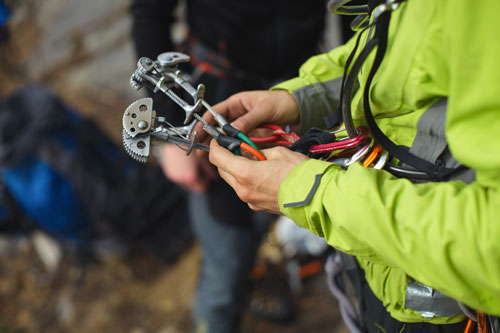This blog has regularly covered trends in adaptive sports. But this is the first time we’ve explored the remarkable world of adaptive rock climbing, aka para-climbing. Although the sport has been around for decades, it’s not as widely known as other adaptive sports, such as skiing or basketball.
In 1982, rock climber Mark Wellman survived a catastrophic fall that left him with a broken back and only limited use of his legs. Despite his injuries, Wellman went back to climbing and eventually became the first adaptive climber to scale El Capitan in Yosemite National Park. That climb and the subsequent publicity Wellman received, “finally got the public’s attention [to adaptive rock climbing], in July of 1989,” according to Craig DeMartino, a writer and adaptive climber.
Rock climbing is widely known as a sport that’s challenging to the body and the mind. Successful climbers must possess strength, flexibility, problem-solving abilities and courage. Fortunately, with appropriate adaptations and highly trained instructors, it can be accessible to just about anyone.
Whether adaptive or traditional, climbing typically requires specialized gear such as climbing ropes, harnesses, climbing shoes, helmets, belay devices and a chalk bag. Climbers with disabilities may need adaptive harnesses that offer additional support for people who lack core strength or need help with balance; adaptive prosthetics specially designed for climbing, and ascenders and pulley systems that assist climbers with limited limb movement. Climbers who are blind or have low vision require help from partners who provide verbal instruction or tap on the climbing wall to let the climber know where they can find wall holds.
In recent years, some climbing gyms have taken it upon themselves to provide walls with features geared toward the needs of people with disabilities. For example, walls at Alta climbing gyms in Arizona have movable hand and foot holds and inclusive climbing routes that cater to the needs of disabled clients. Additionally, these gyms are designed with access ramps and elevators so their climbing walls can be easily accessed by wheelchair users.
As you might expect, climbing has many physical benefits. It builds strength, improves coordination and increases endurance. It also offers emotional fosters the development of resilience, confidence, and leads to feelings of empowerment and well-being.
Another bonus? Many climbers with disabilities find that their climbing gyms or group climbing trips create a wonderful sense of community.
Though adaptive climbing is typically done at climbing gyms, some programs exist for disabled people who want to experience the beauty of outdoor climbing. For example, Paradox Sports in Colorado offers outdoor rock climbing, ice climbing and mountaineering experiences for people with disabilities. The nonprofit also provides training to instructors at other climbing gyms. Adaptive Climbing Group (ACG) is another terrific adaptive climbing resource. ACG offers indoor and outdoor climbing experiences at locations in New York City, New York State, New Jersey, Massachusetts, Hawaii and Chicago, Illinois.
For more information, visit paradoxsports.org or adaptiveclimbinggroup.org.


